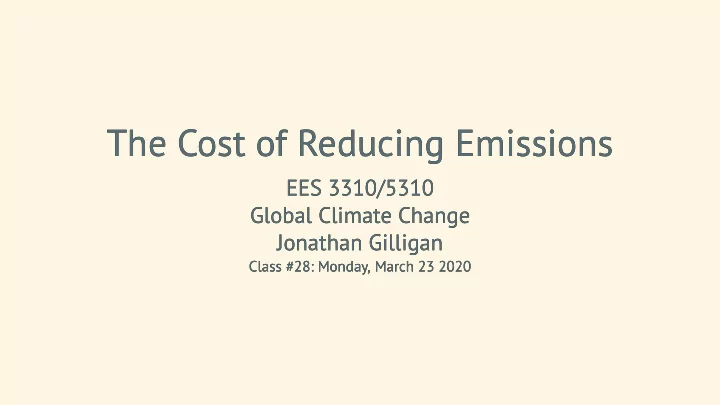

The Cost of Reducing Emissions The Cost of Reducing Emissions EES 3310/5310 EES 3310/5310 Global Climate Change Global Climate Change Jonathan Gilligan Jonathan Gilligan Class #28: Class #28: Monday, March 23 Monday, March 23 2020 2020 /
Big Concepts Big Concepts /
Big Concepts Big Concepts Cost per ton of reducing emissions Marginal vs. average cost Diminishing marginal returns on investment (increasing marginal cost of mitigation) A different look at top-down vs. bottom-up Implications for policy: The importance of participation The need for new technology Market-driven vs. command-and-control Comparison: Pielke vs. Nordhaus /
The cost of reducing emissions The cost of reducing emissions /
Top-down vs. Bottom-up Top-down vs. Bottom-up Climate Fix (Pielke) Climate Fix (Pielke) Climate Casino (Nordhaus) Climate Casino (Nordhaus) Top-down = macroeconomic calculation Top-down = macroeconomic calculation Bottom-up = individual components of Kaya Bottom-up = Engineering: identity: Individual energy technologies Technology: Nuclear e = energy intensity Coal f = carbon intensity Gas … /
The cost of reducing emissions The cost of reducing emissions /
Assumptions Assumptions Top Down Top Down Bottom Up Bottom Up No negative-cost options All technology is new $100 bill on sidewalk What about existing Examples: infrastructure? … /
Potential for Emissions Reduction Potential for Emissions Reduction /
Nortel Nortel Electronics manufacturing CFC-113 for cleaning circuit boards Cheap, safe Concern about ozone layer: 1988: Voluntary pledge to eliminate CFCs Citrus-based cleaner: Even cheaper No chemical disposal costs $1 million initial costs $4 million savings in first 3 years /
Walker’s Crisps Walker’s Crisps British snack-food company Makes potato chips Buys potatoes by the pound Farmers sell by the pound Make sure potatoes are as wet as possible Humidified warehouses Cost of shipping Dry potatoes make better chips Walker’s must dry potatoes Cost of heating, dehumidifying Changed the way they bought potatoes Saved money, reduced CO 2 emissions /
Home energy ef�ciency Home energy ef�ciency Insulation, weatherization $1000 on sealing leaks saves $500 per year Improving insulation Costs $0.25–$2.75 per square foot Savings $0.50–$2.90 per square foot per year Payback time <1 year to 6 years So why don’t people do things that save money and help environment? Don’t know what to do Too much bother/inconvenience Can’t afford up-front costs … /
The Household Sector The Household Sector /
Who Emits CO 2 ? Who Emits CO /
“The Behavioral Wedge” “The Behavioral Wedge” Dietz, Gardner, Gilligan, Stern, & Vandenbergh (2009) Households can cut emissions ~38% With the right incentives, households could be persuaded to cut emissions 20% 450 million metric tons of CO 2 per year 7.35% of total US emissions More than the whole nation of France /
Policy Implications Policy Implications /
Climate Casino on Policy Climate Casino on Policy Different actions have different costs/ton Same action may have different costs at different firms Government doesn’t know enough to micromanage actions efficiently Put a cost on carbon and let market allocate actions Those who can cut emissions cheaply do a lot Those for whom cutting emissions is expensive do less What matters to the environment is total cuts, not whether everyone cuts the same amount. /
Participation Participation Full participation vs. only countries representing 50% of emissions /
Nordhaus on Policy Nordhaus on Policy The favorite policies of most countries today are energy efficiency regulations…. However, such regulations will not touch the area where reductions are most economical—electricity generation from coal. … [C]areful analyses show that coal is king when it comes to reducing CO2 emissions. /
Nordhaus on Policy Nordhaus on Policy Economists and policymakers do not have the information to micromanage the energy system for 315 million Americans or 7 billion earthlings. The economy is too complicated and evolves too rapidly. Rather, … economists emphasize that policy should be designed to provide strong incentives to reduce CO2 emissions and to develop new low-carbon technologies. /
Bill Gates on Policy Bill Gates on Policy We need an energy revolution Put a price on carbon to motivate the market But … Markets are not good at revolutionizing energy Failure rates of venture-capital investments Government does very well at investing in basic research Calls for massive government support for energy R&D /
Recommend
More recommend